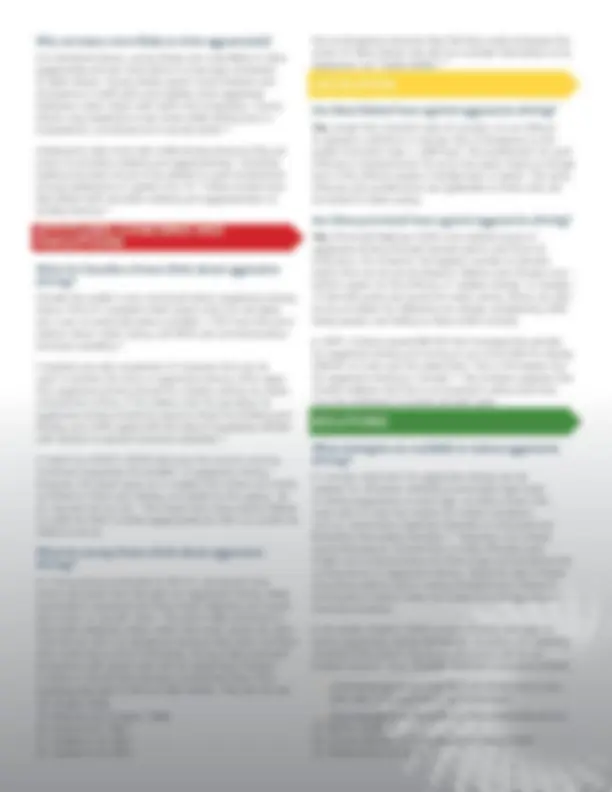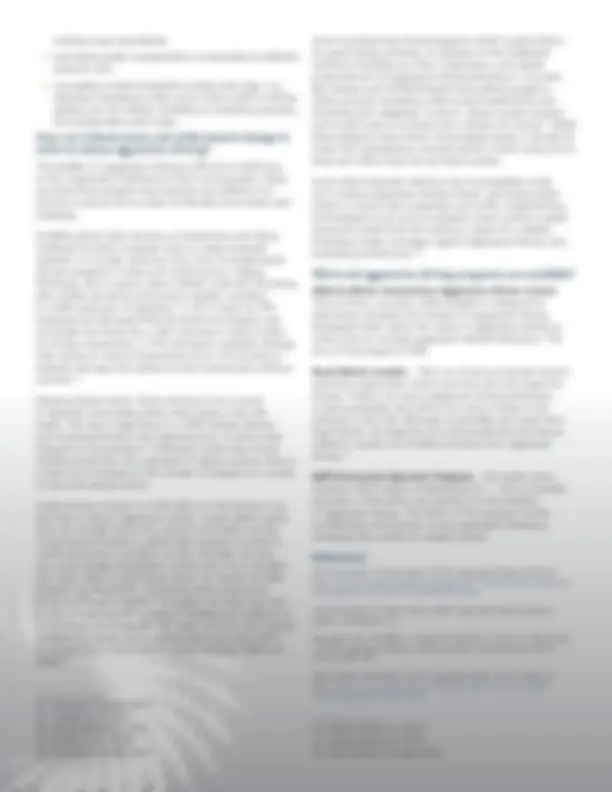





Study with the several resources on Docsity

Earn points by helping other students or get them with a premium plan


Prepare for your exams
Study with the several resources on Docsity

Earn points to download
Earn points by helping other students or get them with a premium plan
Community
Ask the community for help and clear up your study doubts
Discover the best universities in your country according to Docsity users
Free resources
Download our free guides on studying techniques, anxiety management strategies, and thesis advice from Docsity tutors
Some factors that can contribute to aggressive driving include: > increases in traffic volume on ... or personal injury as a result of aggressive drivers.10.
Typology: Lecture notes
1 / 5

This page cannot be seen from the preview
Don't miss anything!




Although many people think of ‘road rage’ when they hear the words aggressive driving, the term includes a wide range of driving behaviours. According to the Traffic Injury Research Foundation (TIRF), aggressive driving includes: running red lights, and speeding up to get through the light; street racing; excessive speeding, and driving well over the speed limit; swearing, and making rude signs at other drivers; using the horn when being annoyed; and, taking risks, just for fun.^1 Excessive speeding is often cited as the most common aggressive driving behaviour.^2 Aggressive driving behaviours are deliberate, intentional, and are not due to driver error.
Road rage is defined as a situation in which a driver or passenger attempts to kill, injure, or intimidate a pedestrian/ driver/ passenger, or damage another person’s vehicle.^3 The difference between aggressive driving and road rage is that physical harm is intended during road rage by the offending driver, whereas aggressive drivers intentionally disregard safety but do not intend to harm others.
There are many factors that can contribute to aggression in drivers and which are dependent on individual and environmental conditions. Some factors that can contribute to aggressive driving include:
Aggressive driving is sometimes a result of displaced aggression, which occurs when a person is provoked in one instance but does not or cannot respond. Aggression is 1 Vanlaar et al. 2007 2 AAAFTS 2009 3 Agerwala et al. 2008 4 Smooth Operator Program 2013 then directed toward a different person or situation.^5 This can cause a waterfall effect where other drivers become increasingly aggressive because of other aggressive drivers.
In the 2006 Road Safety Monitor (RSM) completed by the Traffic Injury Research Foundation (TIRF), respondents admitted to:
The same study reported that the majority of Canadians (88%) believe that there is actually more aggressive driving today compared to five years ago.^6 Estimates of the number of aggressive driving episodes in the United States (U.S.) reach as high as 1.8 billion per year. There was an estimated 28,000 deaths involving aggressive driving behaviours between 1990 and 1996. About one-quarter of drivers admit they drive aggressively at some time.^7 The number of reported aggressive drivers varies according to the behaviours that are included in the definition. For instance it is estimated that there are as many as two red light runners per hour at urban intersections.^8 A similar study revealed that 1 in 5 respondents reported running one or more red lights when entering the last ten signalized intersections.^9 Among teens:
experienced attempted or actual damage to their vehicle or personal injury as a result of aggressive drivers.^10
had raced or passed a vehicle in a no passing zone at least once in the last year. An even larger percentage 5 Agerwala et al. 2008 6 Vanlaar et al. 2007 7 Miles and Johnson 2003 8 Porter and England 2000 9 Retting et al. 2008 10 Smart et al. 2007
reported driving 30 km/h over the speed limit; 80% of boys and 70% of girls had done so in the past year.^11
Crash data involving aggressive driving incidents varies depending on the different behaviours and definitions of aggressive driving that are taken into account. Since the definition of aggressive driving and its behaviours are interpreted differently in some cases, calculating resulting injuries or fatalities is difficult. It is also hard to measure the level of intent of aggressive drivers without asking them directly, a factor that is not usually included in most databases. For instance, a drowsy driver may swerve into another lane and appear to be taking aggressive action when in fact they did not mean to swerve at all. These factors, among many others, may or may not be taken into account when measuring the prevalence of aggressive driving. The American Automobile Association Foundation for Traffic Safety (AAAFTS 2013) estimates that aggressive driving behaviours account for over half of all fatal crashes. That is a significant amount that demonstrates the severity of the problem.
Aggressive driving has a huge economic cost. The National Highway Traffic Safety Association (NHTSA) attributes $40. billion to speeding-related crashes each year in the U.S., and this accounts for only one of the many aggressive driving behaviours (2008).
Different aggressive driving behaviours tend to occur at varying times and places. However, one of the primary locations for aggressive driving is at traffic intersections. An Ontario study revealed that disobeying the traffic signal was observed in 42% of fatal crashes and 29% of injury crashes occurring at intersections.^12 A Quebec study also found a high prevalence of road crashes, just over one-quarter, occurring at traffic intersections due to aggressive driving.^13 While it might be assumed that speeding, one of the most common forms of aggressive driving, would mostly occur on open roads and highways this is not always the case. According to Transport Canada (2011), among young adult drivers, the primary location for fatal crashes involving speeding, as well as alcohol, is urban roads at night. This is due to the fact that urban centers have a greater number of establishments (e.g., restaurants and bars) that serve alcohol. BEHAVIOURS
instances, driving conditions can cause annoyance and 11 Arnett et al. 1997 12 Ministry of Transportation Ontario 1998 13 Brault, Auger, and Montegiani 2007 stress (e.g., high congestion conditions which lead to road rage). Since drivers are less visible to other drivers it is easier to express rage under anonymity.
an aggressive personality they are more likely to drive aggressively. If they are already stressed or become stressed from the act of driving, this may be acted out as road rage. Being aggressive and stressed may lead drivers to misperceive other drivers’ behaviours as personal attacks (e.g., cutting someone off to be rude versus making an honest mistake).
age, sex, and socio-economic background. Certain demographic variables are associated with an increase in aggressive driving behaviours. In a 2006 RSM survey conducted by TIRF, it was found that young drivers (ages 16-24) were more likely to use their horn when annoyed (12%) compared with older drivers (5%). Further differences are outlined in the following section.
Sex differences among aggressive drivers have been widely reported in research. For example, men tend to engage in risky driving, react more aggressively to congestion, and become revengeful and physically aggressive more often than women.^14 Furthermore, femininity in women is positively correlated with lower driving aggression. “Macho” males, on the other hand, score higher on the driving aggression scale.^15 To illustrate, the 2006 RSM found that there were more than double the percent of male aggressive drivers than there were female aggressive drivers (16% versus 6%). Age factors have also been shown to correlate to aggressive driving indicators. In the 2006 RSM, drivers ages 16-44 were more likely to drive aggressively compared to drivers ages 45 and older (15% versus 6%).^16 Other factors related to aggressive driving include:
17, and those with young passengers;
parents driving aggressively).^17 14 Sharkin 2003 15 Agerwala et al. 2008 16 Vanlaar et al. 2007 17 Agerwala et al. 2008; Paleti et al. 2010; and Vanlaar et al. 2007
rushing to get somewhere;
pressure; and,
relaxation techniques while stuck in slow traffic or before getting into the vehicle, breathing or stretching exercises, and prerecorded audio tapes.
The problem of aggressive driving is difficult to tackle due to the magnitude of behaviours that it encompasses. Many countries have adopted new practices and policies in an attempt to reduce the number of offenders and create safer roadways. Installing photo radar cameras at intersections and along roadways has been a popular tactic to target excessive speeders. In Canada, there are only a few municipal speed camera programs in cities such as Edmonton, Calgary, Winnipeg, and in various cities in British Columbia. Promising pilot studies are being conducted in Quebec, resulting in a 44% reduction in speeding.^26 A 2011 report by TIRF evaluated the Winnipeg Photo Enforcement program and concluded that there was a 24% decrease in injury crashes at camera intersections, a 13% decrease in property damage only crashes at camera intersections and a 2% increase in property damage only crashes at other intersections without cameras.^27 Despite positive results, there continues to be a sense of wariness surrounding photo radar systems from the public. This was a major issue in a 1995 Ontario election and consequently led to the abandonment of photo radar programs in the province.^28 Although studies have shown positive results from the utilization of speed cameras, there is a need for an increase in the number of programs in Canada to have the greatest effect. Implementing changes to traffic lights at intersections may also help to reduce aggressive driving. Longer yellow signal time can actually reduce the amount of red light running. A one second increase in yellow light duration can lead to a 50% reduction in red light running. Red light cameras can automatically photograph a driver who runs a red light and mail a ticket to their house which can reduce red light violations by 40%-50%. Combining both would be an ideal and effective solution.^29 European countries have had success in reducing the number of fatalities and collisions at intersections and roadways with speed cameras. For instance, fatalities and serious injury crashes were reduced by 42% at camera sites in the United Kingdom between 2000 and
2004.^30 26 Transport Canada 2011 27 Vanlaar et al. 2011 28 Weisenthal et al. 2013 29 Retting et al. 2008 30 Transport Canada 2011 Some countries have tested programs which reward drivers for good driving practices, as opposed to the traditional method of handing out fines, suspensions, and vehicle impoundment for aggressive driving behaviours. Countries like Sweden and the Netherlands have piloted programs which promote remaining within posted speed limits and refraining from tailgating. In return, drivers receive rewards such as gift cards or entrance into a lottery for money.^31 While these programs have shown encouraging results, it should be noted that maintaining a rewards system is both costly and its long-term effects have not yet been studied. Some other proposed solutions that municipalities could use to reduce aggressive driving include: promoting public transit to reduce road congestion and traffic; implementing technologies in cars such as adaptive cruise control or speed governors (which limit the maximum speed of a vehicle); increasing media campaigns against aggressive driving; and, increasing enforcement.^32
Alberta Motor Association Aggressive Driver Course This one hour, two-part, online program is designed to help drivers recognize the dangers of aggressive driving. Participants learn about the causes of aggressive driving as well as how to manage aggression-related behaviours. The cost of this program is $30. Road Watch Canada – This is an Ontario provincial citizen’s reporting organization which promotes safe and respectful driving. Citizens can report aggressive driving behaviours to local authorities who will in turn send a notice to the offender in the mail. Although no penalties are issued from Road Watch, the objective is to raise awareness and reduce collisions, injuries and fatalities resulting from aggressive driving.^33 NHTSA-Smooth Operator Program - This public safety initiative, which began in Washington D.C., aims to provide education, information and solutions for the problem of aggressive driving. The efforts of the program involve coordinating enforcement to stop aggressive driving by increasing the number of citations issued.
AAA Foundation for Traffic Safety. (2013). Aggressive Driving. Retrieved from: https://www.aaafoundation.org/aggressive-driving?button=Aggressive Driving&gclid=CLKi-9qn87kCFepFMgodoHUAgg. AAA Foundation for Traffic Safety. (2009). Aggressive Driving: Research Update. Washington, D.C. Agerwala, S.M., Chiffriller, S., Hogan, B., Samuels, S., Votta, A., Yannocone, J. (2008). Aggressive driving in young motorists. Humanities and Social Sciences 2(4), 182. Alberta Motor Association. (2013). Aggressive Driver Course. Retrieved from: http://www.ama.ab.ca/driver-education/driver-education-online- courses#aggressive_driver_course. 31 Weisenthal et al. 2013 32 Weisenthal et al. 2013 33 Road Watch Canada 2010
Arnett J.J., Offer, D., Fine, M.A. (1997). Reckless Driving in Adolescence: ‘State’ and ‘Trait’ Factors. Accident Analysis and Prevention 29(12), 57-63. Beirness, D.J., Simpson, H.M. (1988). Lifestyle correlates of risky driving and accident involvement among youth. Alcohol, Drugs and Driving 4, 193-204. Brault, M., Auger, A., & Montegiani, M. (2007). La sécurité aux intersections: analyse des comportements des conducteurs au feu rouge. Présentation à la XVIIe Conference Canadienne Multidisciplinaire sur la Sécurité Routière à Montré al. Miles, D.E., Johnson, G.L. (2003). Aggressive driving behaviors: are there psychological and attitudinal predictors? Transportation Research Part F 6(2), 147-161. Ministry of Transportation Ontario. (1998). Ontario Road Safety Annual Report 1997. Toronto. National Highway Traffic Safety Administration (NHTSA). (2006). Teen Unsafe Driving Behaviours: Focus Group Final Report. DOT HS 810 670. U.S Department of Transportation. Washington, DC. National Highway Traffic Safety Administration (NHTSA). (2008). Traffic Safety Facts: Speeding. Retrieved From: http://www-nrd.nhtsa.dot.gov/ Pubs/811166.pdf Porter, B.E., England, K.J. (2000). Predicting Red-Light Running Behavior: A Traffic Safety Study in Three Urban Settings. Journal of Safety Research 31(1), 1-8. Retting, R.A., Ferguson, S.A., Farmer, C.M. (2008). Reducing Red Light Running Through Longer Yellow Signal Timing and Red Light Camera Enforcement: Results of a Field Investigation. Accident Analysis and Prevention 40, 327-333. Road Watch Canada. (2010). Awareness, Education, and Enforcement. Retrieved from: http://www.roadwatch.ca/Start.aspx. Sharkin, B.S. (2004). Road Rage: Risk Factors, Assessment, and Intervention Strategies. Journal of Counseling and Development 82(2), 191. Smart, R. G., Stoduto, G., Adlaf, E. M., Mann, R. E., Sharpley, J. M. (2007). Road Rage Victimization Among Adolescents. Journal of Adolescent Heath 41, 277-282. Smooth Operator Program. (2013). Retrieved from: http://www. smoothoperatorprogram.com. Transport Canada. (2011). Road Safety in Canada. Retrieved from: http:// www.tc.gc.ca/eng/roadsafety/tp-tp15145-1201.htm#s. Vanlaar, W., Robertson, R., Marcoux, K. (2011). Evaluation of the Photo Enforcement Safety Program of the City of Winnipeg: Final Report. Ottawa, ON: Traffic Injury Research Foundation. Vanlaar, W., Simpson, H., Mayhew, D., Robertson, R. (2007). The Road Safety Monitor 2006: Aggressive Driving. Traffic Injury Research Foundation. Ottawa, Canada. Wiesenthal, D. L., Lustman, M., Roseborough, J. (2013). Aggressive Driving: What is it and What Can Be Done. The Canadian Association of Road Safety Professionals.